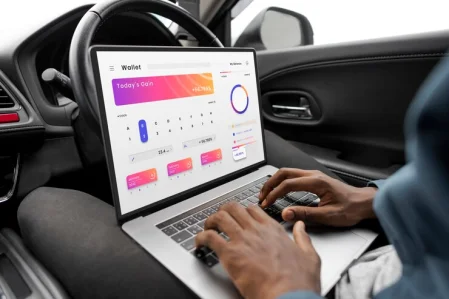Dreaming of building a software app is easy; bringing it to life and onto millions of devices, however a different game! As our world grows more digital, apps aren’t just “nice-to-haves” anymore— they’re often at the heart of businesses, brands, and everyday life. But on a higher note, how much does it cost to develop an app and turn an idea into a downloadable reality? This is one question that frequently gets passed around startups, entrepreneurs, and decision-makers across the globe.
The mobile app industry is booming! As per research from Statista, the global market size of mobile applications was estimated to be $437.75bn in 2022, and is projected to reach a market volume of $781.70bn by the end of 2029 with a CAGR of 7.48% from the forecast period (2022-2029). Yet with such massive demand, costs vary as widely as the features users expect. Success lies in planning, knowing which factors drive budgets, and making informed choices every step of the way. This guide breaks down everything you need to know about the cost to develop an app. So let’s begin!
App Development Cost: Quick Breakdown
The average cost to develop an app depends heavily on the scope and ambition of the project. Some apps—like basic calculators or simple informational tools—require modest investment, while complex platforms with interactive features, custom UI, or real-time data sync can be significantly more expensive. The market for apps is highly lucrative, but success requires an upfront commitment of resources for planning, design, development, and ongoing maintenance.
Cost as per Development Phase
To help visualise how the budget can shift throughout the app creation journey, here’s a breakdown by development phase, with estimated costs and descriptions based on recent data in 2025:
| Development Phase | Estimated Cost ($) | Description |
|---|---|---|
| Discovery | $4,500 – $8,000 | Aligning audience needs with business goals and validating the concept. |
| Prototyping & Design | $15,000 – $30,000 | Crafting user experience, wireframes, and visual aesthetics. |
| Development | $35,000 – $75,000 | Coding the app, implementing features, and integrating third-party services (accounts for 50–70% of the budget). |
| Quality Assurance | $8,000 – $18,000 | Testing for usability, performance, and device compatibility. |
| Deployment | $2,000 – $4,000 | App store submission, backend transfer, and final verification. |
| Maintenance (annual) | 25% of the total app cost | Updates, bug fixes, server upkeep, and ongoing improvements post-launch. |
The total average cost for a professionally developed app in 2025 ranges between $80,000 and $250,000, with the actual price determined by complexity, desired features, technology, and team expertise.
This upfront investment opens the door to a thriving app business. Still, careful budgeting at every phase is crucial to successfully bring your idea from concept to launch—and keep it growing.
Cost as Per Complexity
App development costs vary significantly based on the project’s complexity, feature set, and the time required to build it. Understanding these tiers helps you set realistic expectations and make smarter budgetary choices. Here’s the revised App Development Cost Breakdown section with a detailed table based on different levels of app complexity:
| App Complexity | Estimated Cost (USD) | Development Time | Description |
|---|---|---|---|
| Simple App | $15,000 – $50,000 | 2 – 4 months | Basic features like user login, simple UI, no backend, or limited integrations. Example: calculators, informational apps. |
| Medium App | $50,000 – $120,000 | 4 – 6 months | More sophisticated UI, integrations such as payment gateways, social media, basic backend. Example: e-commerce, on-demand services. |
| Complex App | $120,000 – $250,000+ | 9 – 12+ months | Advanced functionalities like real-time synchronization, AI algorithms, multi-language support, a strong backend, and security. Example: social media, fintech, enterprise apps. |
Key Factors Affecting The App Development Cost in 2025
The cost of developing mobile applications is based on their basic feature and their device upon which they function. The location of the development team also influences the overall price. For instance, building a healthcare or biotech app will demand a high level of security and compliance, which will significantly influence the cost. Several key elements shape how much you’ll pay to develop an app.
Each factor influences project scope, required resources, and timelines, directly impacting the final budget. Here’s a detailed breakdown of each factor along with an overview table:
1. Outsourcing vs. In-House Development
Choosing between hiring internal teams and outsourcing can dramatically affect your budget. In-house development offers control and closer oversight but comes with higher salaries, benefits, and infrastructure costs. Outsourcing, meanwhile, can reduce expenses by leveraging global talent but requires strong project management to ensure quality and communication.
| Development Type | Cost Range | Advantages | Considerations |
| In-House | High (salaries + overhead) | Full control, dedicated team | Expensive, resource-heavy |
| Outsourcing | Lower to moderate | Cost-effective, flexible access | May face communication issues |
2. Platform Choice (Android vs iOS)
Developing an Android application, iOS app, or both affects cost due to different programming languages, devices, and store requirements. Native development for both platforms essentially doubles the effort compared to single-platform development. Cross-platform tools can help save time and money, but may compromise on performance slightly.
| Platform | Cost Impact | |
|---|---|---|
| Android Only | Lower | Wider device base, complex testing |
| iOS Only | Moderate | Unified device specs simplify development |
| Both Platforms | Highest | Requires separate builds and testing |
3. App Complexity
Complexity is the most significant driver of cost. Simple apps with basic functions are cheaper, while intricate apps with advanced features require more development time and expertise. Complex apps also demand extensive testing and maintenance.
| Complexity Level | Estimated Cost Range (USD) | Characteristics |
|---|---|---|
| Simple | $15,000 – $50,000 | Basic features, simple UI, and a few integrations |
| Medium | $50,000 – $120,000 | More features, backend integration, moderate UI/UX |
| Complex | $120,000 – $250,000+ | Advanced features, real-time data, AI/ML, multi-language |
4. Features & Functionality
Features like social logins, push notifications, payment gateways, chatbots, or video streaming app development takes more time and cost. Each new feature must be designed, coded, and tested correctly.
| Feature Type | Cost Impact | Examples |
|---|---|---|
| Basic | Low | User registration, info pages |
| Intermediate | Moderate | Payments, geolocation, APIs |
| Advanced | High | AI, AR/VR, real-time sync |
5. Native vs. Hybrid
Native apps provide optimal performance tailored to specific platforms but require separate codebases for iOS and Android. Hybrid or cross-platform apps development use shared code, reducing costs and development time, but may sacrifice some UX smoothness.
| Development Type | Cost Range | Pros | Cons |
|---|---|---|---|
| Native | Higher | Best performance, UX | More expensive, duplicated effort |
| Hybrid | Lower | Faster development, unified | Slightly compromised UX/performance |
6. Visual Design Complexity
Visual appeal varies widely—simple layouts are cost-effective, while custom animations, illustrations, and branded designs require experienced designers and more time. The design must align with your brand and user experience goals.
| Design Level | Cost Impact | Details |
|---|---|---|
| Basic | Low | Standard UI components |
| Moderate | Moderate | Custom graphics, UX flow |
| High | High | Animations, transitions, branding |
7. Third-Party Integrations
Integrating APIs for payments, analytics, maps, or CRMs speeds development but also adds complexity and application maintenance challenges. Every integration requires testing to ensure smooth operation.
| Integration Type | Cost Impact | Examples |
|---|---|---|
| Few | Low | Google Maps, basic analytics |
| Multiple | Moderate to High | Payment gateways, social logins, and CRM systems |
8. Backend Infrastructure
Apps requiring secure backend servers, databases, and real-time data handling need specialized development and hosting, increases the costs. Backend scalability and security compliance also influence pricing.
| Backend Requirement | Cost Impact | Considerations |
|---|---|---|
| Minimal | Low | Static content apps |
| Moderate | Moderate | User profiles, data sync |
| Complex | High | Real-time sync, IoT, high-security |
9. Location & Team Rates
Development costs vary significantly by geographic region. Eastern Europe, Asia, and Latin America offer cost-effective talent, while North America and Western Europe charge premium rates. Your choice will impact the budget but not necessarily the quality if managed well.
| Location | Hourly Rate Range (USD) | Description |
|---|---|---|
| North America | $80 – $150+ | High quality, high cost |
| Western Europe | $60 – $120 | Skilled, moderately expensive |
| Eastern Europe | $30 – $50 | Cost-effective, growing market |
| Asia | $15 – $40 | Affordable, large talent pool |
You can also Read: iOS App Development Cost in 2025
Web App Development Cost: A Comprehensive Breakdown
Most Common Hidden & Ongoing Costs
When budgeting for mobile app development, it’s vital to understand that the upfront build is just a part of the total investment. Hidden and ongoing costs often take businesses by surprise and can significantly impact the overall budget. These expenses exist to maintain, secure, and grow your app continually, ensuring it stays competitive and functional as technology and user expectations evolve.
| Cost Type | Estimated Monthly Cost (USD) | Description |
|---|---|---|
| Maintenance & Updates | 15-25% of development cost | Bug fixes, feature updates, and OS compatibility |
| Hosting & Infrastructure | $200 – $5,000+ | Servers, cloud storage, and scaling costs |
| Security & Compliance | $500 – $2,000 | Patching, legal compliance, and data protection |
| Third-Party Services | $50 – $1,000+ | Payment processors, SDK licenses, API usage |
| App Store Fees | $2 – $20 monthly equivalent | Developer accounts and commission on sales |
| Marketing & Acquisition | Varies widely | Paid ads, ASO, influencer marketing |
1. Maintenance and Updates
Launching your app is only the beginning. Regular maintenance is necessary to fix bugs, update features, and ensure compatibility with operating system upgrades. Annual maintenance costs typically amount to 15–25% of your initial development budget and can be higher in the first year due to intensive bug-fixing and adjustments post-launch.
2. Hosting and Infrastructure
Apps with backend servers, databases, and cloud storage require ongoing hosting fees. These costs fluctuate based on user traffic and data needs, sometimes ranging from a few hundred to several thousand dollars monthly. Scaling your infrastructure to meet growing demand adds to these costs.
3. Security and Compliance
Staying compliant with evolving data protection laws (GDPR, HIPAA, PCI DSS) and patching security vulnerabilities requires periodic investments. Compliance updates, penetration testing, and data encryption efforts are critical to protect user data and maintain trust.
4. Third-Party Services and API Fees
If your app relies on third-party services (payment gateways, analytics, social login), you may face recurring subscription or usage fees. These ongoing costs depend on the volume of transactions or data, but are essential to keep your app’s ecosystem functional.
5. App Store and Licensing Fees
Both Apple App Store and Google Play charge yearly developer fees ($99 and $25, respectively) and sometimes take a percentage cut of in-app purchases. Additionally, licensing costs for software development kits (SDKs) or proprietary tools may apply.
6. Marketing and User Acquisition
Building your app doesn’t end at launch. Marketing campaigns, app store optimisation, influencer partnerships, and advertising cost money but are necessary to attract and retain users.
Conclusion
Estimating the cost to develop an mobile app is a complex task that depends on numerous factors such as app complexity, platform choice, features, and team location. While the upfront investment might seem significant—ranging from tens to hundreds of thousands of dollars—it’s essential to view app development as a strategic commitment rather than a one-time expense. Taking time to plan and balance your requirements with your budget can help ensure a smooth development journey and successful product launch.
So, if you’re ready to develop and bring your app idea to life? Contact us now!


 Healthcare App Development Services
Healthcare App Development Services
 Real Estate Web Development Services
Real Estate Web Development Services
 E-Commerce App Development Services
E-Commerce App Development Services E-Commerce Web Development Services
E-Commerce Web Development Services Blockchain E-commerce Development Company
Blockchain E-commerce Development Company
 Fintech App Development Services
Fintech App Development Services Fintech Web Development
Fintech Web Development Blockchain Fintech Development Company
Blockchain Fintech Development Company
 E-Learning App Development Services
E-Learning App Development Services
 Restaurant App Development Company
Restaurant App Development Company
 Mobile Game Development Company
Mobile Game Development Company
 Travel App Development Company
Travel App Development Company
 Automotive Web Design
Automotive Web Design
 AI Traffic Management System
AI Traffic Management System
 AI Inventory Management Software
AI Inventory Management Software
 AI Software Development
AI Software Development  AI Development Company
AI Development Company  AI App Development Services
AI App Development Services  ChatGPT integration services
ChatGPT integration services  AI Integration Services
AI Integration Services  Generative AI Development Services
Generative AI Development Services  Natural Language Processing Company
Natural Language Processing Company Machine Learning Development
Machine Learning Development  Machine learning consulting services
Machine learning consulting services  Blockchain Development
Blockchain Development  Blockchain Software Development
Blockchain Software Development  Smart Contract Development Company
Smart Contract Development Company  NFT Marketplace Development Services
NFT Marketplace Development Services  Asset Tokenization Company
Asset Tokenization Company DeFi Wallet Development Company
DeFi Wallet Development Company Mobile App Development
Mobile App Development  IOS App Development
IOS App Development  Android App Development
Android App Development  Cross-Platform App Development
Cross-Platform App Development  Augmented Reality (AR) App Development
Augmented Reality (AR) App Development  Virtual Reality (VR) App Development
Virtual Reality (VR) App Development  Web App Development
Web App Development  SaaS App Development
SaaS App Development Flutter
Flutter  React Native
React Native  Swift (IOS)
Swift (IOS)  Kotlin (Android)
Kotlin (Android)  Mean Stack Development
Mean Stack Development  AngularJS Development
AngularJS Development  MongoDB Development
MongoDB Development  Nodejs Development
Nodejs Development  Database Development
Database Development Ruby on Rails Development
Ruby on Rails Development Expressjs Development
Expressjs Development  Full Stack Development
Full Stack Development  Web Development Services
Web Development Services  Laravel Development
Laravel Development  LAMP Development
LAMP Development  Custom PHP Development
Custom PHP Development  .Net Development
.Net Development  User Experience Design Services
User Experience Design Services  User Interface Design Services
User Interface Design Services  Automated Testing
Automated Testing  Manual Testing
Manual Testing  Digital Marketing Services
Digital Marketing Services 
 Ride-Sharing And Taxi Services
Ride-Sharing And Taxi Services Food Delivery Services
Food Delivery Services Grocery Delivery Services
Grocery Delivery Services Transportation And Logistics
Transportation And Logistics Car Wash App
Car Wash App Home Services App
Home Services App ERP Development Services
ERP Development Services CMS Development Services
CMS Development Services LMS Development
LMS Development CRM Development
CRM Development DevOps Development Services
DevOps Development Services AI Business Solutions
AI Business Solutions AI Cloud Solutions
AI Cloud Solutions AI Chatbot Development
AI Chatbot Development API Development
API Development Blockchain Product Development
Blockchain Product Development Cryptocurrency Wallet Development
Cryptocurrency Wallet Development About Talentelgia
About Talentelgia  Our Team
Our Team  Our Culture
Our Culture 
 Healthcare App Development Services
Healthcare App Development Services Real Estate Web Development Services
Real Estate Web Development Services E-Commerce App Development Services
E-Commerce App Development Services E-Commerce Web Development Services
E-Commerce Web Development Services Blockchain E-commerce
Development Company
Blockchain E-commerce
Development Company Fintech App Development Services
Fintech App Development Services Finance Web Development
Finance Web Development Blockchain Fintech
Development Company
Blockchain Fintech
Development Company E-Learning App Development Services
E-Learning App Development Services Restaurant App Development Company
Restaurant App Development Company Mobile Game Development Company
Mobile Game Development Company Travel App Development Company
Travel App Development Company Automotive Web Design
Automotive Web Design AI Traffic Management System
AI Traffic Management System AI Inventory Management Software
AI Inventory Management Software AI Software Development
AI Software Development AI Development Company
AI Development Company ChatGPT integration services
ChatGPT integration services AI Integration Services
AI Integration Services Machine Learning Development
Machine Learning Development Machine learning consulting services
Machine learning consulting services Blockchain Development
Blockchain Development Blockchain Software Development
Blockchain Software Development Smart contract development company
Smart contract development company NFT marketplace development services
NFT marketplace development services IOS App Development
IOS App Development Android App Development
Android App Development Cross-Platform App Development
Cross-Platform App Development Augmented Reality (AR) App
Development
Augmented Reality (AR) App
Development Virtual Reality (VR) App Development
Virtual Reality (VR) App Development Web App Development
Web App Development Flutter
Flutter React
Native
React
Native Swift
(IOS)
Swift
(IOS) Kotlin (Android)
Kotlin (Android) MEAN Stack Development
MEAN Stack Development AngularJS Development
AngularJS Development MongoDB Development
MongoDB Development Nodejs Development
Nodejs Development Database development services
Database development services Ruby on Rails Development services
Ruby on Rails Development services Expressjs Development
Expressjs Development Full Stack Development
Full Stack Development Web Development Services
Web Development Services Laravel Development
Laravel Development LAMP
Development
LAMP
Development Custom PHP Development
Custom PHP Development User Experience Design Services
User Experience Design Services User Interface Design Services
User Interface Design Services Automated Testing
Automated Testing Manual
Testing
Manual
Testing About Talentelgia
About Talentelgia Our Team
Our Team Our Culture
Our Culture


![A Guide to Mobile Application Architecture - Everything You Need to Know [2026]](https://www.talentelgia.com/blog/wp-content/uploads/2025/12/mobile-app-architecture-f.webp)














 Write us on:
Write us on:  Business queries:
Business queries:  HR:
HR: 




